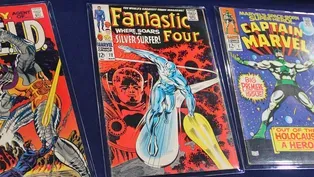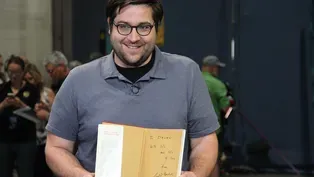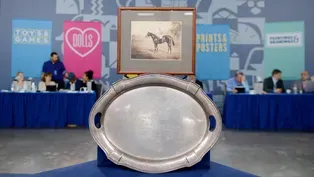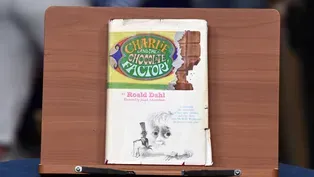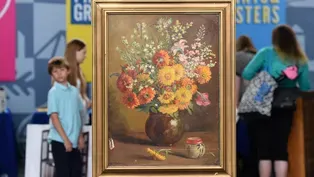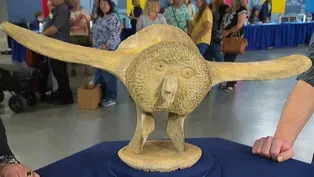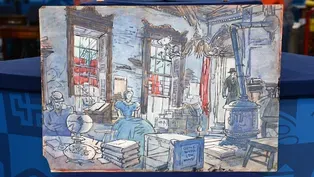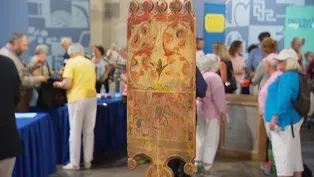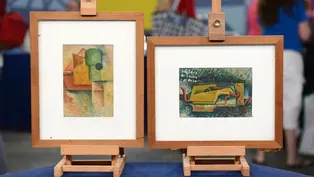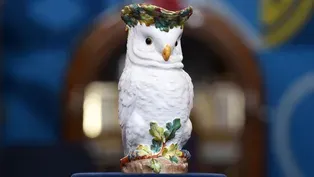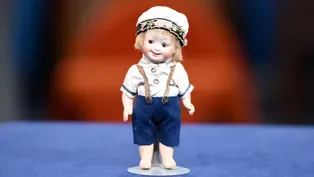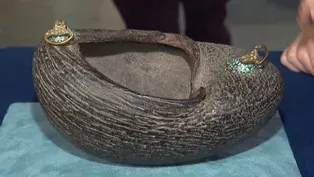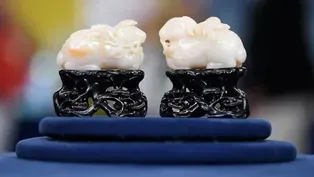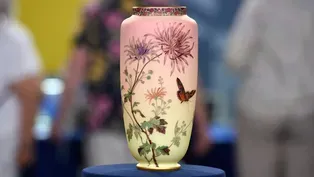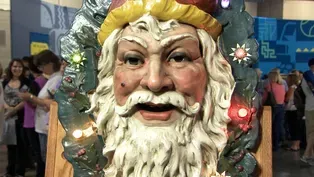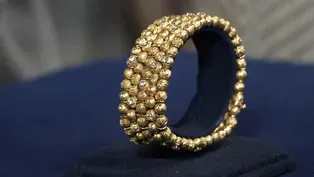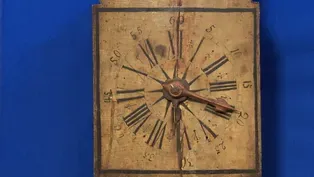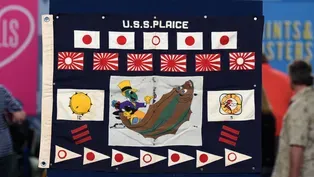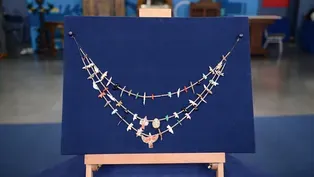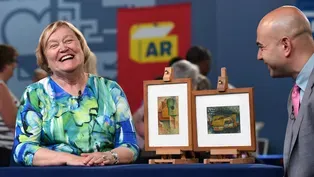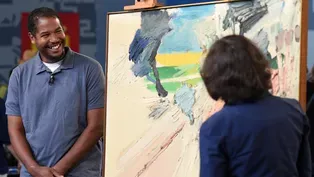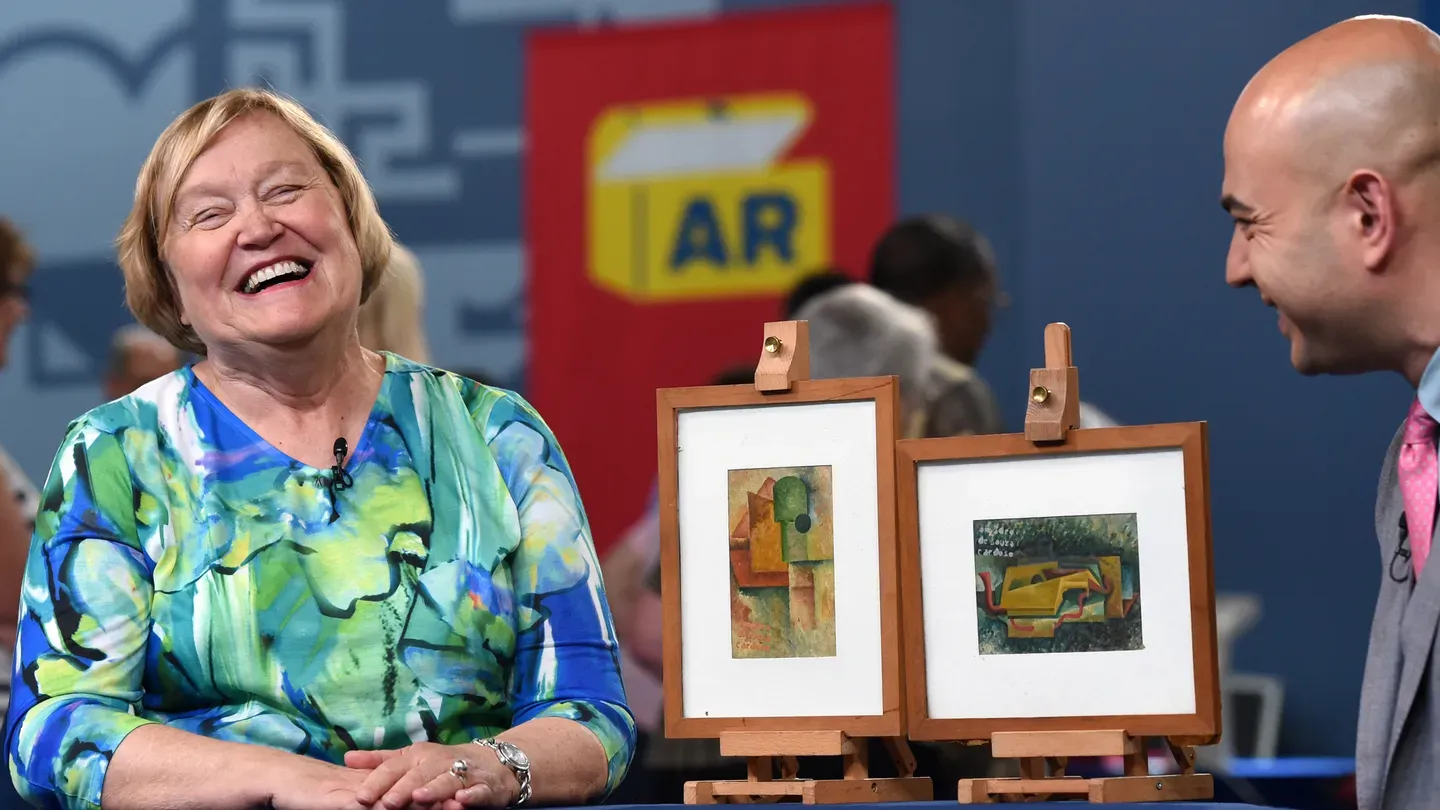

Spokane, Hour 1 (2016)
Season 20 Episode 1 | 52m 59sVideo has Closed Captions
Celebrate our 20th anniversary with a new generation of treasures, plus a six-figure find!
Celebrate our 20th anniversary with treasures like a 1919 Belmont Stakes trophy, 1963 "The Avengers" comics, and two Amadeo de Souza-Cardoso oil paintings. Which find is worth $200,000 to $300,000?
Problems with Closed Captions? Closed Captioning Feedback
Problems with Closed Captions? Closed Captioning Feedback
Funding for ANTIQUES ROADSHOW is provided by Ancestry and American Cruise Lines. Additional funding is provided by public television viewers.

Spokane, Hour 1 (2016)
Season 20 Episode 1 | 52m 59sVideo has Closed Captions
Celebrate our 20th anniversary with treasures like a 1919 Belmont Stakes trophy, 1963 "The Avengers" comics, and two Amadeo de Souza-Cardoso oil paintings. Which find is worth $200,000 to $300,000?
Problems with Closed Captions? Closed Captioning Feedback
How to Watch Antiques Roadshow
Antiques Roadshow is available to stream on pbs.org and the free PBS App, available on iPhone, Apple TV, Android TV, Android smartphones, Amazon Fire TV, Amazon Fire Tablet, Roku, Samsung Smart TV, and Vizio.
Buy Now

ANTIQUES ROADSHOW 2025 Tour!
Enter now for a chance to win free tickets to ANTIQUES ROADSHOW's 2025 Tour! Plus, see which cities we're headed to!Providing Support for PBS.org
Learn Moreabout PBS online sponsorshipMARK WALBERG: From Spokane, Washington, it's the season premiere of Antiques Roadshow.
It's a vase, or a "vahse."
I would call it a "vahse."
Okay.
That is crazy.
Wow, my mom is going to freak out.
WALBERG: Antiques Roadshow is celebrating 20 years on television.
ALL: Happy anniversary!
(applause and cheering) WALBERG: And there are still so many treasures to discover all across America in places like Spokane, Washington.
Downtown, Riverfront Park was nonstop fun.
While inside the convention center, we found some marvelous comics rescued from an attic.
Check it out.
MAN: When I was a kid, I would go down to a store in Pullman, Washington, and buy candy and comics.
And my mom knew this, of course.
And so one day, I'm at work, and she calls me and says, "I'm down at the auction."
They were selling stuff that people had left in storage units too long.
And she said there were two boxes of comics, and did I want to have her bid on them, and I said, "Sure."
And so she brought them home, and in the box were these two comics.
And about five months ago, she calls me, and I had a whole bunch of stuff in their attic.
She said she needed me to come and take them out of the attic because they were taking up too much space and they were consolidating stuff.
Now, do you have any idea what she paid for the box of comics at auction?
Yeah, she paid $24 for the box.
Only one box, but you said there were two up for auction.
There were two boxes, and she looked in the other one, and there were some toys in the top, but comics underneath.
And this one was filled with comics, so she bid on that one, which to this day, I kind of wonder what might have been in the other box.
Well, you brought in a tremendous collection of comics.
But I chose only two.
We have The Avengers number one from September of 1963, and Avengers number two from November of 1963.
So the reason I chose these two comics is because right now, the Avengers are very big in the public consciousness.
In 2015, Marvel Comics released their latest movie, Avengers: Age of Ultron, and you've got coming out in his first movie very soon...
I heard about this-- Ant Man.
Ant Man.
I mean, these are some of the most iconic Marvel superheroes.
And it's written by Stan Lee, the art by Jack Kirby, with just creators of such amazing, amazing characters-- stuff we both grew up with and grew to love.
And then we've got Avengers number two, and it introduces a new character, the Space Phantom, which, unfortunately, I don't think anyone really knows about anymore.
One thing about comic books that really changes the value on them is condition.
Now, these aren't in what we would consider mint condition.
Right.
Far from it.
You've got creases by the staples, you've got a section in here that is completely folded back.
You've got what we call a rolled cover, which means the cover is slightly offset.
Especially on this one, it's particularly bad.
These are what we'd call "very good."
This one would be a "very good minus."
This one would be around a "very good plus."
Kind of in that range.
Do you have any idea what the value might be on them?
I honestly really don't.
At auction, in what we would consider unprofessionally graded condition, this would sell for around $450 to $550.
Really?
Wow.
That's really cool.
But Avengers number one, we estimate in this condition, it would probably sell at auction for between $4,000 and $6,000.
No way!
You are kidding me.
In that condition?
Wow!
My mom is going to freak out.
I cannot believe that she kept them all these years.
She's totally not going to believe this story.
Seriously, wow.
Oh, my God, it's unbelievable.
That is amazing.
I don't even want to touch them now.
(laughing) Mom, you did good.
(both laugh) WOMAN: I found this on a rummage sale two weeks ago.
I love it because I love the flower.
I asked the lady how much cost, and she say five dollar.
And I say, "Well, has some damage.
I offer you three dollar."
And she say, "Okay, you have it."
My husband say, "No way, what you do with this?"
And I say, "It's so beautiful.
Even if we put in the hall or somewhere, it's so nice."
Well, I'm so glad that you brought it to Antiques Roadshow, because it is something special.
It's by an artist named Marie Seebold Molinary, and she was a Louisiana artist.
She knew at a young age that she would want to be an artist.
Her father was an art gallery owner.
She studied under William Merritt Chase, she studied at the Art Institute of Chicago and did all of the right things to become a well-known and important artist in her day.
Wow.
She in fact was the second woman to become a member of the New Orleans Artists Association, and this is a great example of her work, and many have sold quite well at auction.
This one was included in an exhibition in the Museum of Fine Arts in Houston, and it was under the title "Flowers" with a price tag of $75.
Probably in the '30s, I'm guessing.
1930?
Yes.
Uh-huh.
This is an oil painting on canvas.
Yes.
And the canvas has been mounted to a board to stabilize the painting.
Uh-huh.
Do you have any idea of what the value would be?
I really don't know.
I think maybe a few thousand, but I am not sure.
Well, this one, because of its condition, I think in its current state could bring $10,000 to $15,000.
That's nice.
The thing about it is you could put some money into restoring it and really increase the value.
I think if you spent maybe $1,000 restoring the painting, it might be worth $15,000 to $20,000.
Wow.
That's great.
Praise the Lord!
I love it.
Hi, Antiques Roadshow.
Hi, Antiques Ro adshow!
MAN: So you're gonna go through the door, and a volunteer will take you to your appraiser.
My mother-in-law gave it to me.
She's in her 90s.
And I don't know much about it at all.
Yep!
APPRAISER: You have a fairly dramatic piece here, Cliff.
Where did you get it?
MAN: It belonged to my grandparents.
When did he get it?
We believe it was in the late '50s.
My mother was a young girl when he went to Alaska, and he befriended a Ketchikan Native there who I believe was the artist of this piece.
I'm not positive about that.
And he came home with this, and it's been in the family ever since.
First of all, this is an Inuit whalebone vertebra sculpture.
And I'm going to turn this thing, because we have two faces.
And it's really spectacular.
Now, I can tell you that this did not come from the Ketchikan area.
This came probably well north, maybe even up as far as Point Barrow.
Oh, wow, okay.
Because that's where you would more likely see the whales.
And even though we can't really establish precisely the age of the whale, clearly we could say it's a 20th century piece.
It's a fantastic sculpture.
They're extremely rare.
And an object like this, realistically, in a gallery environment, I would expect to see it sell for $2,500 to $4,500.
In a good showroom, I think it could go higher than that.
It's a great piece.
Excellent.
MAN: It's been in my house since as long as I can remember-- Charlie and the Chocolate Fa ctory by Roald Dahl.
It was my mom's book, and then I had it because I loved it as a kid.
I read it several times as a kid.
It really captured my imagination.
You read this particular copy?
Yes.
There's something pretty special inside here.
An inscription says, "To Steven, with lots of love, from Roald Dahl," and a date.
Who's Steven?
I asked myself that exact question.
I actually was, like, on the Internet trying to be like, "Is there a Steven Dahl?"
I was like, "Maybe it's a relative or something."
But no one in my family that I know of goes by Steven, so no idea.
You acquired the book from your mother.
Where did your mom get the book?
I've never actually asked her, but I think I will now.
But yeah, I have no idea.
Well, I was pretty amazed when we opened the book up and found the autograph in there.
Charlie and the Chocolate Factory is Roald Dahl's most famous book, adult or for children, and an autographed copy, that makes it somewhat valuable in itself.
But in your research about the book, what did you learn about it?
Well, very minimally, I was just looking to find if it was a first edition, and then I didn't realize that there could be various printings of a first edition.
I read something that said there was about 10,000 copies of the first edition, first printing, and that you could tell that by, I think, the number of lines on the "colophone," or the... Colophon.
Colophon.
And so I had to look up what that was.
And then once I figured out what that was, I looked to see if there were six lines.
Well, speaking of the colophon, this is the copyright page of the book.
And on it, we have the six lines of type that you mentioned, not five.
That is one of the points of the first edition.
It's only one of the points.
In addition to the lines of type on the copyright page, we need a price on the dust jacket, which we have, and we also need to not have an ISBN number, International Standard Book Number, on the rear flap of the dust jacket.
Your book has all the salient points to be a first edition of the children's classic.
That's awesome.
The number printed in 1964 was 10,000 copies.
We don't know the exact number.
It's a "more or less" figure.
And in modern first editions, both adult and children's, the value is in the dust jacket.
Oh.
As well as the autograph.
Interesting.
The jacket's still present.
Now, you read this book as a child, correct?
Yes, I did.
So there's some holes here, and some tears and chipping.
That was probably me.
In the antiquarian book world where I live, condition is everything.
Your copy is about very good condition.
But it does have the jacket, it has the first edition points, and it has the all-important autograph.
I would appraise your book at retail for between $5,000 to $6,000.
Wow.
That is crazy.
That is insane.
If the young Tim had read the book more carefully and kept it in better condition, it would probably bring in the $9,000 to $12,000 range.
Treasure it-- it will only become more valuable over time.
Well, thank you so much.
This doll was obtained by my mother some years ago, and she in turn gave it to me.
She loved to collect antiques, she loved dolls.
I think she bought this on one of her trips to Germany when she was visiting my sister.
How long have you had it?
I've had it a few years.
I just don't know anything about it.
I figured I'd bring it today to see if I could solve the mystery.
Anything in particular that you like about it?
Well, I like how the eyes kind of float up and down, and the detail is really nice on the face, and it just has a lot of character to it.
You brought in a wonderful example of a bisque-headed German googly.
Okay.
It's a very nice example.
The size is good, the clothes are all original.
The fact that it has such an impish look, very unusual.
Most people love googlys, especially people that collect dolls.
Oh, okay.
And you look at him, and he's in a toddler body.
He's marked in the back of the head.
Okay.
"K&H," and also "Mold Number 180."
Okay.
The "Mold Number 180" indicates the mold number of his face, the look, his looks.
Oh, okay.
Also, "K&H" is a company out of Germany-- Kley and Hahn.
Their heads were made by another company called Hertel and Schwab.
Oh.
The googly dolls came about between 1911 and 1915.
They're very nice dolls.
Did it ever have shoes, do you think, originally, or...?
It could have had shoes.
I'm not positive.
The feet look in such good condition that it may have had shoes at one time.
Have you ever had him appraised?
You know, I really have no idea of the value.
And that's why I brought it today, because I just really had no idea, and I figured you could help me solve the mystery on what I have and how old it is, and maybe the value.
Sometimes big surprises come in small packages, even though he's a smaller version of this doll.
And people love the smaller version.
We're talking anywhere from $1,500 to $2,000 in today's market.
You're kidding me.
At auction, it could bring more.
You're kidding me.
Not at all.
I had no idea.
I totally didn't know any idea of value on this.
WOMAN: This necklace was given to me by my mother, who received it from her sister, who did a lot of trading with the Native American pueblos in New Mexico.
I grew up in Santa Fe, New Mexico.
My parents moved there from Michigan in 1942.
They just traded with the Indians a lot.
Well, they must have had a lot of fun doing it-- I can sense they did.
They did.
Do you have any sense of what pueblo this is from?
I'm afraid I don't.
Okay.
No, I don't.
It's from the Zuni, Zuni Pueblo.
Okay.
An ancient Pueblo, occupied for well over 1,000 years.
One of the things I think that's so interesting about this necklace, the fetishes are actually inspired by ancient fetishes that are pre-contact, maybe as much as 1,000 years old.
Oh, my gosh.
There was a trader in the Southwest named C.G.
Wallace, and he encouraged silversmiths and arts and crafts workers amongst the Native tribes to do innovative things, and this was very innovative.
Yes, it is.
It's called a fetish necklace, and there are many fetishes here.
We have an eagle fetish, a frog fetish, a bear, many birds, another bear.
It's really quite a remarkable grouping of animals.
And these are all animals of the natural world that would be in the Zuni world.
The materials are wonderful, and there's quite a few of them.
Yes?
There's spondylus shell, different types of shell, jet, turquoise, coral.
It's really a remarkable set of materials.
Yes.
The spondylus shell, which is hand-carved, has two colors.
It has the metallic sort of shiny shell color underneath, and then when it's carved, there's the red color.
So it's really intentionally worked for the variety of color here.
You'll notice many of the eyes are black.
That has jet in them.
The little frog is antler, deer antler.
I thought it was.
The little beads are called heishe.
Those are shell beads.
They're hand drilled.
And that's the little connections between all of the fetishes.
Okay.
I think this was made by one of the most famous jewelers of the Southwest, a gentleman named Leekya Deyuse.
He was born in 1889, died I believe in the 1960s.
He is the preeminent Zuni fetish carver.
He just worked... Oh, my gosh.
Yeah, really spectacular.
He worked with hand tools, he used chisels, sandpaper, different things to work the shell down into a beautiful depiction.
If it's not made by Leekya Deyuse, it would have, I think, been made by his daughter Alice.
And in either case, it's quite special.
And she followed in her father's footsteps.
I think on a retail basis, this would sell for about $3,500.
And if we could determine without any doubt that it is by Leekya, then I think we could double that, and we'd have a value, a retail value, of about $7,000.
Oh, my gosh.
You've kept it in good shape.
You want to continue to keep it in good shape.
I've tried to take very good care of it.
Okay, very good.
Wonderful.
Thank you.
Enjoy, good luck.
MAN: It's a Daisy double-barrel BB gun.
MAN: I was going to pull out the photo with Lonnie.
We've had a lot of Nakashima come through on the Antiques Roadshow over the years, and I think this one is kind of fascinating because it illustrates a little about what George Nakashima was all about.
Oh, yeah?
When did you buy it?
Oh, I got it in about '97 or '98.
And how much did you pay for it?
$600.
$600?
That's very surprising.
If you help me lift it up, I want to show a couple of elements here.
This is called a Q bench.
It was originally designed in the late '50s and it was typically made for families in the early '60s, and you would order these, but he would make it specifically for you.
And I sold one very recently that was a little bit shorter, and it didn't have this crevice in it.
This one has this really nice, long, deep crevice with a little butterfly joint.
That's what George Nakashima was known for.
He was known for letting the wood show off all of its natural beauty.
If the client wished, he would cut around it and make one without a crevice if they'd like, but he preferred the crack because it showed off the natural elements of the wood.
And the difference between one with a crack and one without a crack is fairly significant.
If this came up at auction, it would bring as much as $20,000.
(laughs) Wow.
Wow!
That's great.
In its day, it probably was sold for about $250 when it was brand new, whoever it was made for in 1961, and if it didn't have the crevice here, it would probably be only worth $15,000.
So that makes this a $5,000 crack.
That's a great crack, I guess-- yeah.
WOMAN: I brought my great- grandfather's trophy that he got for the Belmont Stakes.
He had a stable at the time that had a number of great racehorses, but the big one was Sir Barton.
And this is the winning trophy for the very first Triple Crown.
So... and tell me about Sir Barton, because he was quite an interesting horse.
Yes, well, he was a horse that inherited bad feet, and he had a really mean disposition.
And they basically had to wear out all these other horses to get him to train.
So for the Kentucky Derby, they put him on there for Billy Kelly so that he'd have a race mate for the race.
And he blew it away.
He got the first race.
So then they...
Okay, well, so then they ran him for the other races.
But he was always a difficult horse, and he ran in spite of his sore feet.
He also was known to be pretty feisty.
He was nasty.
Apparently, you wouldn't want to go near him.
Didn't like humans.
No, didn't like humans.
Didn't like animals either.
He ran four races in 32 days.
Yes.
So he ran the Kentucky, and everybody was surprised that he won.
Then they turned around and said, "Well, we'll put him in the Preakness," and he blew that one away, too.
And then he ran the...
I think it was the Withers Stakes.
And then they put him in the Belmont, and he ran the Belmont and he did really well.
Yeah, and he was placed in the Kentucky Derby just as a rabbit, just to tire out the other horses, and never looked back.
What else do you remember about him?
He was a horse that basically never really liked to run.
Because they could never get him to run, it was hard to keep him in shape.
So what I understood was that they really didn't know whether they were going to be able to have him ready each time that he ran.
And so as we're sitting here today talking about the first Triple Crown winner, we were told earlier today that American Pharoah won the Triple Crown this year.
I know, it's amazing.
First time in 37 years.
It's amazing.
So we have this sterling tray here, awarded for winning the Belmont Stakes in 1919.
All inscribed with the owner's name.
Is there anything about polishing I should know?
It's accepted to polish something like this.
It is, okay.
It'll show nicer.
From the standpoint of athletic trophies, perfectly acceptable.
And they're beautiful when they're shined up, so...
Okay.
When you look at comparables, you'll see there was a silver loving cup trophy that was awarded to Sir Barton for the Belmont Stakes.
That sold at auction for $17,000 in 2006.
Wow.
We would place an auction estimate on the tray at $15,000 to $25,000.
Wow.
Wow, that's pretty cool.
For an insurance figure, I would place an insurance amount of $35,000.
Okay.
Well, that's wonderful.
Well, I bought it about 20, 25 years ago at a little antique shop in Oregon.
It was so unusual.
At the time, I hadn't seen anything like it.
And I said, "I have to have it."
I think I paid $75 for it.
And we've had it all these years.
I found the company, but I can't find any records of the company making this particular piece.
Well, when you say you found the company, let's turn it over and look at the mark.
There's a mark here.
Is this what you're referring to?
Yes, what I have not been able to find is this particular mark.
Well, what you're looking at is two marks.
This is not the company mark, in fact.
This is a retailer mark-- a retailer from Boston from the second half of the 19th century.
This is the company mark.
And if you look at them, they're kind of obliquely set.
So this was stamped first, this was stamped later.
And this is the mark of a well-known English porcelain company called Crown Derby.
Oh, okay.
Crown Derby is known widely as Royal Crown Derby, we call it, but in fact, this wasn't Royal Crown Derby at this point.
Didn't become that until 1890.
Now we know who made it.
And you say you had to have it, and we hear that sometimes, but tell me a little more about that.
It's just a very unusual piece.
I've seen pitchers before, but not figural pitchers, and especially owls.
And it's got such beautiful artwork on it.
And that's... it's just eye appealing.
Do you have a thing about owls?
Do you collect owls?
I do, I do.
Growing up as a kid, we had a great big barn, and we had white barn owls that slept in the barn.
And it just reminded me of that, and I thought, "Well, that's probably going to be my only chance to get a white barn owl."
So I figured, "Let's just go with this one."
Well, it's always great when an object reminds you of a happy time in your life or childhood.
So it is, as you say, an owl.
It's actually not a barn owl.
It's kind of a generic owl, I would say.
Okay.
But white and strong and superbly modeled, which is what you'd expect, by the way, from Crown Derby.
Okay.
At the time, the time in this case being, I would say, about 1875, something like that, they were really among the top three porcelain manufacturers in England in terms of their quality-- well established, very highly respected, with a strong network of distributorship, including in this country.
Okay.
So this would have appealed to and found its way to a fairly wealthy American home at the time.
Okay.
And it's a jug, of course.
I call it a jug rather than a pitcher because it's English, and "jug" is the English vernacular for what we call in America a pitcher.
And jugs of this type, Victorian jugs, were intended to use.
They would be used in a conservatory, maybe, for lemonade or iced water or something like that.
Well, I think you did just fine in terms of what you paid for it.
It's a great auction piece, I think, because if you put it at auction, it would photograph beautifully.
It's in great condition.
I would think if it came to auction, the right auction estimate would be between $700 and $900.
Wow, okay.
Now, having said that, you know how it works at auction.
If two or three people...
Right, right.
But that would be the estimate that's... That's wonderful, that's wonderful.
It was a good investment.
I'm glad I have it.
I mean, it's a beautiful piece.
WOMAN: My dad got them from a family when he was in Formosa.
It was in the middle of the '50s.
All he told us was that a family that he had stayed with and was friends with gave him that as a parting gift when he came home.
Do you have any idea how old they are?
Did you have any assumptions?
Yes, my father had taken them to the museum in San Francisco at one time in a brown bag on the bus.
(laughs) And he said that they said it was the Qianlong dynasty, 1735 to 1796.
And that was all the information.
I see.
So... Well, although they appear to be in the style of the Qianlong period, during the latter part of the 18th century, the imperial workshops then were highly skilled and continued to develop into the 19th century.
That tradition continued actually into the Republic period, between 1911 and 1949.
Now, the symbolism of these pieces is really universal in China.
These are rams, which are symbols of male power, one of the 12 zodiac figures.
And they are actually biting what they call Lingzhi fungus here, which are symbols of immortality.
Oh.
So you have power and immortality in these pair of rams.
You can see the fungus on the back.
You can also see a sun in swirling clouds here.
And the complementary wooden bases pick up this decoration.
These are white jade with russet skin.
And while they were done in the style of pieces which were carved during the Qianlong period, they're actually done, we believe, in the Republic period.
Oh.
Which started in 1911, and of course ended with the founding of the People's Republic in 1949.
And the fact that your dad acquired these in China in the 1950s firmly places them as a pre-1950s object, which in the current international market for Chinese jade is quite important.
It provides a provenance and a terminus date for these two pieces.
Now, mainland Chinese buyers who love white jade would think that these are highly desirable, even if they are not 18th century.
So what do you think they're worth?
(laughs): I don't know.
I was told once they were worth about $2,000.
Well, as Republic period pieces, at auction, they would be worth, or carry a presale estimate, of at least $15,000 to $25,000.
Whew!
Wow.
Now, if in fact they were Qianlong, they would be worth considerably more, maybe $80,000 to $120,000.
Hi, so what have you brought today?
Good morning, and what did you bring with you today?
Old Sparky the robot.
Old Sparky the robot.
Well, I think we're going to send you along to toys.
I hope you have a great day.
WOMAN: What kind of horse do you ride?
WOMAN: My grandsons call him Scary Santa.
He was given to me by my husband about 15 or 16 years ago as a Christmas gift.
I collect vintage and antique Christmas items.
And I know he's made of plaster, he displays my lights beautifully, the manufacturer name is on him, and a date, but I've never been able to find a thing out about him.
You mentioned its mark, and it's in the mold.
Copyrighted 1913, Modern Tuscany Art Company.
The Modern Tuscany Art Company was chartered in 1913 in Pennsylvania.
That doesn't mean this is from 1913.
I think this is actually from about the 1940s.
Oh.
The last names of the principals of the firm were Pellegrini and Provincielli.
So there's your Tuscany Modern Art Company, I think.
This is made to be a store display for Christmas, draw attention to what they're selling, possibly even the lights.
It is in almost mint condition.
If I were to advise you on an insurance estimate, I would put a value of $1,500 on it.
Oh, wow.
Oh, wow, that's wonderful.
WOMAN: Well, this is a military flag from my father.
He was in World War II on a submarine, the Plaice.
As far as I understand, these all represent Japanese shipping that they killed or shot during the war.
There is a lot of symbology with these, and the interesting thing about them is that it's not exactly standard.
But essentially, the goal is to tell the story of the ship's service.
It's hard to discern who made these because it varies from vessel to vessel and circumstance to circumstance.
There aren't really any hard and fast regulations.
We have the name of the vessel, the USS Plaice, which was a Balao-class submarine launched in 1943.
The Plaice conducted war patrols in the South Pacific towards the end of World War II.
And what we see on the flag is the insignia of the vessel, which is a Disney- inspired design.
Walt Disney was very involved in military insignia in World War II, designing it, very enthusiastic supporter of the war effort, and a lot of ships and vessels carried Disney- inspired insignias.
And what we see here is a record of the ship's service in those patrols.
Starting at the top, the regular Japanese flags indicate merchant vessels that were sunk during the operations of the Plaice.
When you see a red disc with a white center, that generally indicates a vessel that was damaged.
Same thing for these.
These are Japanese war flags.
Each one of those denotes a warship that they engaged.
These, of course, the same as the merchant ships, these denote a ship that was successfully sent to the bottom.
And this denotes a ship that was damaged.
Okay.
These tend to indicate mine-laying missions.
Oh, that they laid the mine.
Exactly.
I wondered.
Also, later on in the war, one of the things that the submarines did to great effectiveness was they were lifeguards for the U.S. Army Air Corps, the Navy, and the Marine Corps.
When they were flying strikes on particular targets, they would station submarines so that they could pick up survivors if they were shot down or they had to ditch at sea.
I was told as a child that they'd gone into Tokyo Bay and picked up a pilot, and I'm not sure if it was this sub or the other one he was on.
I did not find that in their history, but what I did find was that they picked up five survivors from a B-25 that had to ditch.
Oh, my gosh.
It's represented on their flag right there with the life raft.
Okay.
So that's what that indicates.
And then the smaller pennants are for shipping that was under a certain tonnage-- small craft like harbor patrol vessels and that sort of thing.
Can you tell me what these represent?
Generally, these hashmarks indicate the number of war patrols that the vessel was on.
Oh.
It has some faults.
Yeah, it does.
The moths got to you a little bit.
That certainly is not something that we would want to have happen, but in this case, it doesn't degrade too significantly from the value of the piece.
Even though this is not the sub's main kill flag, of which there is one per vessel, a flag like this on the retail market would sell for between $2,500 and $3,000.
Oh, my goodness, I had no clue, none.
That's amazing.
My grandfather was Paul Lincoln, and I believe this Captain Charles Lincoln was his great-grandfather.
It's not that ship portraits of the early 19th century are terribly rare, but they are desirable, they're very collectible, and we know a little bit about the captain.
He was born very early in the 19th century in Brewster, Massachusetts, on Cape Cod.
He worked for a company that traded between Boston and the Mediterranean ports, and they basically, I think, shipped fruit and that sort of thing.
There were a number of artists who did ship portraits, and they had to be reasonably accurate from a technical standpoint, and probably it was at the request of the ship owner or the skipper of the ship.
It's in pretty good condition.
The background is a little toned, and that's the result of the paper being against probably a wooden back.
But it's remarkably in its original ebonized frame with those little brass rosettes.
So this picture would date from maybe 1825 or '30, so it's a relatively early ship picture.
Uh-huh.
This would bring predictably, at least at auction, probably between $3,000 and $5,000.
Desirable picture.
In the process of looking through the box with the papers, we found something else that isn't directly related to this.
I would suspect that it probably came down in the family, and that's why it's in that box.
We kind of gasped when we saw this.
This is an 18th century flame stitch wallet.
It's handmade, probably made by a girl or a young lady maybe in school, or at least a woman who had learned needlework, so she was very proficient.
Considering your family's history, I would not be surprised if this originated in Massachusetts, made between maybe 1760 and 1780.
So it's a lot older than the ship portrait.
Over the years, we've handled a number of these flame stitch wallets.
There are a couple of things about this, and one thing in particular that I have never, ever seen before.
This wallet pictures a black woman with a teapot and a teacup in a long dress.
And when we turn it over, the flap side pictures a black manservant.
He has a tray with a goblet on it.
I have never seen a piece of 18th century needlework depicting black servants.
And it's interesting to note that they are very well attired.
I mean, the woman is in a long dress, and the man himself is in a long red coat, so they're in formal attire, and they had very specific jobs to do in the family.
I think that they could possibly have been slaves.
We don't really know that; we can only make that conjecture.
It's in pretty good shape.
It has very good color.
It's a bit worn.
There probably was some sort of button or clasp which is long gone.
The interior is wool, divided into sections.
But all in all, when you consider how old this is, and the fact that these are all vegetable dyes, which can be very fugitive, this could have been eaten to nothing by moths.
Somehow, it's been kept from considerable harm.
And having never seen a wallet with this pictorial depiction of people, at auction, we think the wallet is probably worth in the area of, let's say, $10,000.
Wow.
Pretty special.
Yeah, sure is.
Yes, indeed.
That's neat.
WOMAN: I got them at an estate sale.
APPRAISER: How long ago?
Oh, about six months ago.
Oh, wow.
Yeah.
And may I ask what you paid for them?
I believe around $100.
Well, that's nice.
I bought a group of things, and they kind of... You know who made them?
Steiff, by Disney.
Yep, and they're the Mickey and Minnie Steiff.
What made you buy these of everything that was at the estate sale?
Well, I had to spruce up my doll collection, and I wanted something that I could pack away and not break.
And so I got into the Steiff, and I really am very interested, and I'm a deep collector now of Steiff.
And these two bring me back to my childhood, because Minnie and Mickey were the big thing when I was a child.
Curious thing to wonder about these Steiffs.
These were made... Mickey and Minnie were made in the 1930s in Germany, which was a rough time over there.
And it's very interesting that a company, old-fashioned company like Steiff, which got into business in the 1880s, got talked into making these wonderful little Mickey and Minnie dolls.
Yeah.
Well, there's an interesting story about that.
We owe these dolls to an unsung hero in toy manufacturing, a man by the name of George Borgfeldt, who was one of the most forward-thinking toy distributors in America.
Starting in the 1920s, he knew the importance of comic character licensing, and he went to Germany and had them make some of the best tin toys.
And of course in the 1930s, Mickey was the great character, and he managed to talk Steiff into making these incredible dolls.
They're velvet, they are very finely crafted, and these are truly exceptional examples, the best I've ever seen.
Really?
What's interesting about these, there's so many areas in which these could fall down in terms of quality and condition.
This fabric is very brilliant and bright, but it's very subject to fading.
These must have been out of the light and in boxes for years to be preserved so beautifully.
Never seen Minnie retaining her original silk bows on her shoes.
Okay.
Never seen Minnie still retaining the little black lines on her eyes.
The eyes, by the way, are cut oilcloth, which they often fall off.
And of course, not only do you have the original button, but you have the original paper tag saying "Steiff Original."
These were made for the American market by Steiff under the auspices of George Borgfeldt, and they're just absolutely exquisite.
The real key pieces of Mickey Mouse material that collectors like is only ten years.
Yeah.
1930-1940.
Because after the war, the characterization totally changed.
Everything about them is spectacular-- the little whiskers on their noses...
They're just absolutely extraordinary.
Now, you paid $100.
You had to be a little excited to find them.
Oh, yes.
Well, I knew they were there, and that's why I wanted the box, because they were in there.
Well, Mickey Mouse toys have... that market has sort of softened up over the years since I've been in the business.
But every once in a while, if something comes along that is exceptional, it changes all the numbers.
And we think an auction estimate on these could be $1,200 to $1,500 for the pair.
Oh, okay.
That's wonderful.
They're just the best.
Really?
The best I've ever seen.
$1,200 to $1,500, that's marvelous.
♪ ♪ WOMAN: It looks very interesting.
WOMAN: It's all real horse hair, and they know that we bought it and everything.
WOMAN: My husband inherited it from his grandmother.
APPRAISER: And no one's ever told you anything about the makers or any of that stuff?
No, uh-uh.
Okay.
It's made by a famous company, Van Cleef and Arpels.
You may have heard of them.
I have.
They're a French outfit.
They make fantastic jewelry, and very renowned for that.
This was made in about the 1950s, early '60s.
And all the beads on this are cast in different styles and patterns.
This is of 18-karat gold, and it does have little round brilliant cut diamonds, and it's set all the way around.
You can't even tell where the clasp is when you look at it.
Right.
It's a very popular item in today's market.
Signed pieces are hot as they've ever been, and I believe an auction value for something like that would be about $10,000 to $15,000.
Oh, my gosh... (laughs) Oh, my gosh, you're kidding.
Well, I'm glad that pleases you.
Oh, my gosh, I never dreamed, I never dreamed.
Oh!
Well, good.
It's a vase, or a "vahse."
I would call it a "vahse."
Okay.
Do you know where it was made?
I have no idea about this.
Would you like to guess?
I thought it looked Asian-ish.
It's interesting that you said Asian, because this period of glass, a lot of times there are Asian influences, particularly Japanese and Chinese influences on art glass from this period.
So I can understand why you'd say that.
The company that made this was Thomas Webb and Sons.
They were an English company.
This is called decorated Burmese glass.
Burmese glass first originated in the United States.
The formula was developed by a man named Frederick Shirley, who was at Mount Washington Glass.
He developed it in 1881, and then he patented it in 1885.
And slightly after that, about a year or so later, he licensed it to Thomas Webb and Sons in England.
In terms of date, I would say late 1880s.
The Burmese glass is actually a translucent glass.
Small amounts of gold, germanium oxide, feldspar, and fluorspar were added to the mix.
The glass itself, the background would start at a salmon color, and then it would gradually turn into this beautiful lemon.
What's so nice about it is it's very gradual.
You don't see an abrupt line where it's salmon and then it goes to lemon.
But what makes this so exceptional is the decoration on it.
It has beautiful chrysanthemums in various stages of development.
It also has this beautiful butterfly, which is always an extra perk for a piece of glass like this.
But the other thing that's interesting is the decorated collar, which is something else.
Like, they went the distance on the piece.
You also have gold outlining it, and even around the foot.
And there's no loss to this at all.
What makes a good piece of decorated Burmese glass is the combination of the shape, the color, and the design.
Another thing that I particularly noticed, that I noticed about this that got me kind of excited, was down below is the original retailer's sticker.
It's still there, and most people would have washed that off.
But the name of this store was Phillips, and it says "Oxford Street," which was in London, so that's where it was retailed.
And I'm happy that no one ever took that off.
How many people did it take to make this?
I assume that first, you have the person or the people that actually blew the glass.
And this is actually blown glass.
And one of the ways to always tell a piece of authentic Webb is that there is a beautiful ground pontil on the bottom, and you can see that right here, how it's been ground.
So first you had people doing that kind of work, and then the decorator would be... probably one person would decorate it, and that would be done in another department.
So two.
At least two.
And where did you get this?
I got it from my mother.
Okay.
And I believe she got it from her mother.
Okay.
And she never discussed it?
I know nothing about it.
Well, something like this, a retail value of this vase would be between $4,000 and $5,000.
Okay.
Thank you.
You're welcome.
WOMAN: They belonged to my grandmother, and I assume my grandfather, but he was deceased at that time.
And she would let us children play with them and buy and sell them in a fake little store we had-- you know, play store.
And where was this?
This was in Liège, Belgium.
Do you know anything about the artist?
You know, no more than Google will tell you-- I mean, that he was a legitimate artist, that he was Portuguese, I believe.
Yes.
Painted in Paris and visited Belgium around the 1920s.
I don't know for what purpose.
Actually, he visited Belgium a little bit earlier.
Earlier, yeah.
Well, let's talk about the artist a little bit.
Okay, please tell me, yeah.
So it's Amadeo de Souza-Cardoso, and he is one of the most important Portuguese modernists of the 20th century.
He lived a short life.
He was born in 1887 and he died in 1918 of the Spanish flu, so he only lived about 30 years.
Right.
But had a very productive career within those 30 years.
Originally, he started studying in Lisbon, but then at the age of approximately 19, he went to Paris to study.
Okay.
Right around 1910, he went to Belgium.
Okay.
Which is also interesting, because these paintings are cubist paintings.
Right, right.
And really, right around 1910, cubism was hot in Europe, and he started developing this style of cubism in his own works and bringing it back to Portugal, eventually.
The medium of these paintings is oil on board.
And these paintings were created circa 1910, it's safe to assume.
He spent a little bit of time in Belgium, and then he went back to Paris.
Now, in Paris, he was friends with quite an illustrious group of artists.
This included Juan Gris, Amadeo Modigliani, and actually, speaking of Modigliani, he was very good friends with Modigliani, and Modigliani even kept his sculptures in de Sousa Cardoso's studio.
Okay.
He was very popular amongst his peers and in that group of core cubists and important early 20th-century modernists.
He also participated in some very seminal art shows, including the Salon des Indépendants.
And in 1913, some of his works were exhibited at the Armory Show in New York.
So they're good places to be, yes.
Very, very good places to be.
And his works were very popular.
They sold at many of those shows, and some of them are in American museums.
It is very unfortunate that he died so early.
There was more interest in the artist until about 1925 or so.
There was even an award created for him in Portugal.
Wow.
But really, his paintings were forgotten after that.
They were somewhat rediscovered in about 1952.
Okay.
In Amarante, where he's from in Portugal.
Do you have any idea of how much they're...
I have no idea, and, you know, quite frankly, I don't particularly like them.
Okay.
I don't like the colors, I'm sorry to say.
If I were going to put these two paintings at auction, as a pair... As a pair, yeah.
I would put an estimate, which is a conservative estimate, of $200,000 to $300,000.
No!
I mean, that is... For the pair.
Oh, my goodness.
That is amazing.
Do you like the colors now?
Not really, but I am feeling that I'm going to have to share with my siblings when I sell them.
Amazing.
I thank you so much, because if the Roadshow had not come to Spokane and I didn't have tickets to come, I probably would have... my kids would have given them to Goodwill.
And now, it's time for the Roadshow Feedback Booth.
And this delightful object, we don't know what it is.
It has a "look."
I used the binoculars to find Edith.
I used the fly rod to catch her.
And now I've got the handcuffs, which I'm capturing her with, and I've kept her for over 50 years.
And he's taken out three people with the rod since he's been here.
And we picked this up at a yard sale for five dollars, and found out that it was worth $400 to $600.
I brought my Daisy double-barreled BB gun, and I found out that it was only made from 1937 to 1940, and when I was a kid, my dad gave it to me, and I used to go on safari all over the neighborhood.
And all I can say is bully, bully.
And we've got the whole world in our hands.
And we're here with an early 20th century satin glass vase.
It was my great- great-grandmother's, and it was my mother's great-grandmother's.
And so we found out today a lot of history about it.
It's been very educational.
And we understand it's made by a company in Tiffin, Ohio.
Not Tiffany, but that's okay.
It's still valuable to us.
My little bear from Alaska in 1938, my mom's trip, isn't worth much, but my copy of Robert Burns from the 1700s is worth about a grand, so that makes me happy.
But the real reason you come is to talk to the folks and see what they brought and just enjoy yourself.
When we came to Antiques Roadshow, we thought it was all about the memories that we brought.
Turned out to be about all of the memories that we made.
Love you, Mom, happy birthday.
It's been great.
We are twins from Idaho.
And we came to Washington... ...with stuff from New Mexico.
And now we're going to Hawaii.
Aloha, Antiques Roadshow.
Thank you!
Muchas gracias!
I'm Mark Walberg, thanks for watching.
See you next time on Antiques Roadshow.
Bonus Video: 1963 "The Avengers" Comics 1 & 2
Video has Closed Captions
Clip: S20 Ep1 | 1m 58s | Bonus Video: 1963 "The Avengers" Comics 1 & 2, from Spokane, Hour 1. (1m 58s)
Owner Interview: 1964 Inscribed Roald Dahl Book
Video has Closed Captions
Clip: S20 Ep1 | 1m 22s | Owner Interview: 1964 Inscribed Roald Dahl Book, "Charlie and the Chocolate Factory" (1m 22s)
Appraisal: 1919 Belmont Stakes Sterling Silver Trophy Tray
Video has Closed Captions
Clip: S20 Ep1 | 2m 44s | Appraisal: 1919 Belmont Stakes Sterling Silver Trophy Tray, from Spokane, Hour 1. (2m 44s)
Appraisal: 1964 Inscribed "Charlie & the Chocolate Factory"
Video has Closed Captions
Clip: S20 Ep1 | 3m 41s | Appraisal: 1964 Inscribed Roald Dahl Book, "Charlie and the Chocolate Factory" (3m 41s)
Appraisal: Marie Seebold Molinary Oil, ca. 1930
Video has Closed Captions
Clip: S20 Ep1 | 2m 26s | Appraisal: Marie Seebold Molinary Oil, ca. 1930, from Spokane, Hour 1. (2m 26s)
Appraisal: Whale Vertebra Sculpture
Video has Closed Captions
Clip: S20 Ep1 | 1m 22s | Appraisal: Whale Vertebra Sculpture, from Spokane, Hour 1. (1m 22s)
Appraisal: "Gone With The Wind" Sketches, ca. 1939
Video has Closed Captions
Clip: S20 Ep1 | 2m 17s | Appraisal: "Gone With The Wind" Sketches, ca. 1939, from Spokane Hour 2. (2m 17s)
Appraisal: 19th-Century Scandinavian Tape Loom
Video has Closed Captions
Clip: S20 Ep1 | 1m 56s | Appraisal: 19th-Century Scandinavian Tape Loom, from Spokane, Hour 1. (1m 56s)
Appraisal: Amadeo de Souza-Cardoso Oils, ca. 1910
Video has Closed Captions
Clip: S20 Ep1 | 3m 32s | Appraisal: Amadeo de Souza-Cardoso Oils, ca. 1910, from The Best of 20. (3m 32s)
Appraisal: Crown Derby Owl Jug, ca. 1875
Video has Closed Captions
Clip: S20 Ep1 | 3m 41s | Appraisal: Crown Derby Owl Jug, ca. 1875, from Spokane, Hour 1. (3m 41s)
Appraisal: Googly-Eyed Kley & Hahn Doll, ca. 1915
Video has Closed Captions
Clip: S20 Ep1 | 2m 16s | Appraisal: Googly-Eyed Kley & Hahn Doll, ca. 1915, from Spokane, Hour 1. (2m 16s)
Appraisal: Late 19th-Century Kashkul Begging Bowl
Video has Closed Captions
Clip: S20 Ep1 | 1m | Appraisal: Late 19th-Century Kashkul Begging Bowl, from Spokane, Hour 1. (1m)
Appraisal: Republic Period Chinese White Jade Rams
Video has Closed Captions
Clip: S20 Ep1 | 3m 21s | Appraisal: Republic Period Chinese White Jade Rams, from Spokane, Hour 1. (3m 21s)
Appraisal: Steiff Mickey & Minnie Mouse Dolls, ca. 1935
Video has Closed Captions
Clip: S20 Ep1 | 3m 59s | Appraisal: Steiff Mickey & Minnie Mouse Dolls, ca. 1935, from Spokane, Hour 1. (3m 59s)
Appraisal: Thomas Webb & Sons Burmese Glass Vase
Video has Closed Captions
Clip: S20 Ep1 | 3m 29s | Appraisal: Thomas Webb & Sons Burmese Glass Vase, from Spokane, Hour 1. (3m 29s)
Appraisal: Tuscany Art Company Composition Santa Plaque
Video has Closed Captions
Clip: S20 Ep1 | 1m 10s | Appraisal: Tuscany Art Company Composition Santa Plaque, from Spokane, Hour 1. (1m 10s)
Appraisal: Van Cleef & Arpels Bracelet
Video has Closed Captions
Clip: S20 Ep1 | 58s | Appraisal: Van Cleef & Arpels Bracelet, from Spokane, Hour 1. (58s)
Appraisal: Wooden Works Cuckoo Clock, ca. 1820
Video has Closed Captions
Clip: S20 Ep1 | 30s | Appraisal: Wooden Works Cuckoo Clock, ca. 1820, from Spokane, Hour 1. (30s)
Appraisal: World War II USS Plaice Kill Flag
Video has Closed Captions
Clip: S20 Ep1 | 3m 29s | Appraisal: World War II USS Plaice Kill Flag, from Spokane, Hour 1. (3m 29s)
Appraisal: Zuni Fetish Necklace, ca. 1935
Video has Closed Captions
Clip: S20 Ep1 | 3m 10s | Appraisal: Zuni Fetish Necklace, ca. 1935, from Spokane, Hour 1. (3m 10s)
Season 20 Premieres Mon, Jan. 4th!
Preview: S20 Ep1 | 30s | Celebrate our 20th anniversary with a new generation of treasures! (30s)
Preview: S20 Ep1 | 1m | ANTIQUES ROADSHOW has a new look for Season 20, premiering Jan 4th at 8/7c on PBS. (1m)
Providing Support for PBS.org
Learn Moreabout PBS online sponsorshipSupport for PBS provided by:
Funding for ANTIQUES ROADSHOW is provided by Ancestry and American Cruise Lines. Additional funding is provided by public television viewers.




